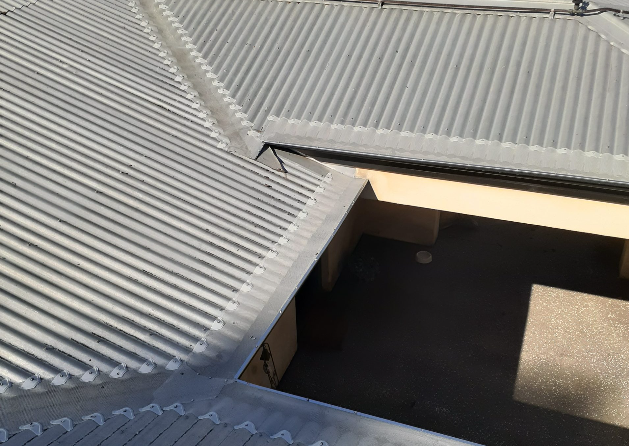
Roof leak repair: How to Find a Roof Leak and What to Do
A leaky roof can be a major headache for homeowners. Not only can it cause water damage to your property, but it can also lead to mold and other health hazards. In this guide, we’ll discuss how to find a roof leak, the different types of leaks, and what you can do for roof leak repairs.
How to Find a Roof Leak?
The first step in fixing a leaky roof is to find where the leak is coming from. It can be tricky, as water can travel along the roof before dripping into your home. However, you can use a few methods to pinpoint the leak’s source.
The Garden Hose Method for Finding Roof Leaks
One method is the garden hose method. Start by spraying water onto your roof in a small area. Next, have someone inside the house check for water dripping down from where you’re rushing. Continue this process until you find the place where water is coming in.
Another way to find a leak is to inspect your attic. First, look for signs of water damage, such as water stains or damp insulation. Then, trace the path of the water damage back to the roof to locate the leak.
Different types of leaks on Roofs.
Several types of leaks can occur on a roof, including:
Damaged or missing shingles: If a shingle is missing or damaged, water can seep through the roof and into your home.
Damaged flashing: Flashing is the metal or plastic material covering the roof’s seams and edges. If it’s damaged or missing, water can seep through these areas.
Clogged gutters: If your gutters are clogged, water can back up and overflow onto your roof, causing water damage.
Condensation: If there’s not enough ventilation in your attic, condensation can build up and cause water damage.
Holes or punctures: Anything penetrating your roof, such as a tree branch or satellite dish, can create a spot and cause water to leak.
How do I fix leaking roofs?
Once you’ve found the source of the leak, you can start to repair it. Here are some steps you can take to fix a leaky roof:
Replace damaged shingles: If a shingle is missing, you must replace it. Remove the old shingle and replace it with a new one. Be sure to use roofing cement to secure it in place.
Repair flashing: If the flashing is damaged, you can repair it with roofing cement. Clean the area around the flashing and apply the glue.
Clean gutters: If your gutters are clogged, clean them out to prevent water from overflowing onto your roof.
Increase ventilation: If you have condensation in your attic, increase ventilation to allow the moisture to escape.
Patch holes: If your roof has a hole, you’ll need to patch it. Use roofing cement and a patching material, such as metal, to cover the gap.
What should I do if my roof leaks?
If you notice a leak in your roof, it’s essential to take action immediately. Here are some steps you can take:
Move furniture and other valuables away from the leak.
Place a bucket or container under the leak to catch any water.
Use a tarp or plastic sheeting to cover any furniture or items that can’t be moved.
Contact a professional roofer to assess and repair the damage.
Leaking roof after a Major Storm
After a significant storm, inspecting your roof for any damage is a good idea.
Even if your roof appears to be intact, there may be hidden damage that could lead to leaks in the future. Here are some steps you can take to check for wear:
Inspect your roof for missing or damaged shingles.
Look for any cracks or holes in the roof.
Check for any damage to the flashing around chimneys, vents, or other openings.
If you notice any damage, it’s essential to contact a professional roofer as soon as possible to assess and repair the damage.
Repairing roof leaks
If you’re comfortable with DIY projects, you can repair small leaks independently. However, it’s best to contact a professional roofer if the damage is extensive or you are still trying to figure out what to do.
When repairing a roof leak, it’s essential to take safety precautions. Always use proper safety equipment, such as harnesses or safety ropes, when working on a roof.
Here are some steps you can take to repair a roof leak:
- Locate the source of the leak.
- Remove any damaged or missing shingles.
- Apply roofing cement to the damaged area.
- Replace the shingles and secure them in place with roofing cement.
- Check for any additional damage and repair as necessary.
Find the source of leaks on your roof.
In addition to the methods mentioned above, there are other ways to find the source of a roof leak. For example, you can use infrared thermography to detect temperature differences on the roof that could indicate a leak.
You can also use smoke pencils to detect air leaks in your home. By lighting a smoke pencil and holding it near the suspected leak, you can see if the smoke is pulled into the roof, indicating a leak.
Conclusion
A leaky roof can be a frustrating problem for homeowners. However, by taking the time to find the source of the leak and taking the necessary steps to repair it, you can prevent further damage to your home. Whether you’re comfortable with DIY repairs or prefer to contact a professional, addressing roof leaks as soon as possible is essential to avoid costly damage and potential health hazards.